
|
Regular exercise and physical activity can reduce the risk of developing some diseases
and disabilities that develop as people grow older. In some cases, exercise is an
effective treatment for many chronic conditions. For example, studies show that
people with arthritis, heart disease, or diabetes benefit from regular exercise.
Exercise also helps people with high blood pressure, balance problems, or difficulty
walking.
A Combination of Four Types of Exercises are Needed for
Emeritus:
1. Endurance activities - like walking, swimming, or riding a bike - which
build "staying power" and improve the health of the heart and circulatory system
2. Strengthening exercises which build muscle tissue and reduce age-related
muscle loss
3. Stretching exercises to keep the body limber and flexible
4. Balance exercises to reduce the chances of a fall
What Are Endurance Exercises?
Exercises that increase your heart rate and breathing for an extended period of
time. They will make it easier for you to walk farther, faster, or uphill. They
also should make everyday activities such as gardening, shopping, or playing a sport
easier.
Examples:
- Walking
- Jogging
- Swimming
- Raking
- Sweeping
- Dancing
- Playing tennis
Endurance Exercise Tips
- Refer to your starting goals, and build up your endurance gradually.
- If you have not been active for a long time, it is especially important to work
your way up over time. It may take a while to go from a longstanding inactive lifestyle
to doing some of the activities in this section.
- For example, start out with 5 or 10 minutes at a time, and then build up to at least
30 minutes of moderate-intensity endurance activity.
- Doing less than 10 minutes at a time will not give you the desired heart and lung
benefits.
- Try to build up to at least 30 minutes of moderate-intensity endurance activity
on most or all days of the week. Every day is best.
- Remember, though, that these are goals, not rules. Some people will be able to do
more. Others, however, may not be able to exercise for 30 minutes at a time. It
is important to set realistic goals based on your own health and abilities.
What Are Strength Exercises?
Any physical activity or exercise that uses the force of a muscle against some form
of resistance to build muscle strength, endurance, and size. Even very small changes
in muscle strength can make a real difference in function, especially in people
who have already lost a lot of muscle. An increase in muscle that you may not even
see can make it easier to do everyday things like get up from a chair, climb stairs,
carry groceries, open jars, and even play with your grandchildren. Lower-body strength
exercises also will improve your balance.
Examples:
- List or pushing weights
- Using resistance bands
- Lifting common objects from your home
- Strength-training equipment at a fitness center or gym
Strength Exercise Tips
- Try to do strength exercises for all of your major muscle groups on 2 or more days
per week for 30-minute sessions each, but do not exercise the same muscle group
on any 2 days in a row.
- Start with light weights and gradually increase the amount of weight you use.Depending
on your condition, you might need to start out using 1- or 2-pound weights or no
weight at all. Your body needs to get used to strength exercises.
- Please remember to practice caution. Starting out with weights that are too heavy
can cause can an injury.
- Gradually add more weight in order to benefit from strength exercises. You need
to challenge your muscles to get the most benefit from strength exercises. We invite
you to visit the Progressing section below to understand how you can do this.
- It should feel somewhere between hard and very hard for you to lift or push the
weight. It should not feel very, very hard. If you cannot lift or push a weight
8 times in a row, it is too heavy for you. Reduce the amount of weight.
- Take 3 seconds to lift or push a weight into place, hold the position for 1 second,
and take another 3 seconds to return to your starting position. Do not let the weight
drop; returning it slowly is very important.
- Try to do 10 to 15 repetitions for each exercise. Think of this as a goal. If you
cannot do that many at first, do as many as you can. You may be able to build up
to this goal over time.
What Are Balance Exercises?
Balance exercises are the exercises you can do to improve your balance. You can
do exercises to improve your balance almost anytime, anywhere, and as often as you
like, as long as you have something sturdy nearby to hold on to if you become unsteady.
Examples
|
Stand on One Foot
|
|
You can do this exercise while waiting for the bus or standing in line at the grocery.
For an added challenge, you can modify the exercise to improve your balance.
|
|
|
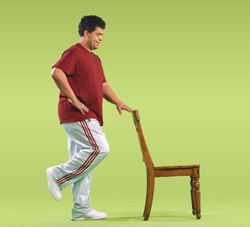
|
|
1. Stand on one foot behind a sturdy chair, holding on for balance.
2. Hold position for up to 10 seconds.
3. Repeat 10-15 times.
4. Repeat 10-15 times with other leg.
5. Repeat 10-15 more times with each leg.
|
|
|
|
Heel-to-Toe Walk
|
|
Having good balance is important for many everyday activities, such as going up
and down stairs.
|
|
|

|
|
1. Position the heel of one foot just in front of the toes of the other foot. Your
heel and toes should touch or almost touch.
2. Choose a spot ahead of you and focus on it to keep you steady as you walk.
3. Take a step. Put your heel just in front of the toe of your other foot.
4. Repeat for 20 steps.

If you are unsteady on your feet, try doing this exercise near a wall so you can
steady yourself if you need to.
|
|
|
|
Balance Walk
|
|
Good balance helps you walk safely and avoid tripping and falling over objects in
your way.
|
|
|

|
|
1. Raise arms to sides, shoulder height.
2. Choose a spot ahead of you and focus on it to keep you steady as you walk.
3. Walk in a straight line with one foot in front of the other.
4. As you walk, lift your back leg. Pause for 1 second before stepping forward.
5. Repeat for 20 steps, alternating legs.

As you progress, try looking from side to side as you walk, but skip this step if
you have inner ear problems.
|
Source: nia.nih.gov
Balance Exercise Tips
- Have a sturdy chair or a person nearby to hold on to if you feel unsteady.
- To challenge yourself, try holding on to the chair with only one hand; then with
time, you can try holding on with only one finger, then no hands. If you are steady
on your feet, try doing the exercise with your eyes close
What Are Flexibility Exercises?
Flexibility or stretching exercises are an important part of your physical activity
program. They give you more freedom of movement for your physical activities and
for everyday activities such as getting dressed and reaching objects on a shelf.
Stretching exercises can improve your flexibility but will not improve your endurance
or strength so it is important to do those exercises as well.
Examples:
|
Neck
|
|
This easy stretch can help relieve tension in your neck. Try to stretch after strength
training and during any activity that makes you feel stiff, such as sitting at a
desk.
|
|
|

|
|
1. You can do this stretch while standing or sitting in a sturdy chair.
2. Keep your feet flat on the floor, shoulder-width apart.
3. Slowly turn your head to the right until you feel a slight stretch. Be careful
not to tip or tilt your head forward or backward, but hold it in a comfortable position.
4. Hold the position for 10-30 seconds.
5. Turn your head to the left and hold the position for 10-30 seconds.
6. Repeat at least 3-5 times.
|
|
|
|
Shoulder
|
|
This exercise to stretch your shoulder muscles will help improve your posture.
|
|
|

|
|
1. Stand back against a wall, feet shoulder-width apart and arms at shoulder height.
2. Bend your elbows so your fingertips point toward the ceiling and touch the wall
behind you. Stop when you feel a stretch or slight discomfort, and stop immediately
if you feel sharp pain.
3. Hold position for 10-30 seconds.
4. Let your arms slowly roll forward, remaining bent at the elbows, to point toward
the floor and touch the wall again, if possible. Stop when you feel a stretch or
slight discomfort.
5. Hold position for 10-30 seconds.
6. Alternate pointing above head, then toward hips.
7. Repeat at least 3-5 times.
|
|
|
|
Shoulder and Upper Arm
|
|
This exercise to increase flexibility in your shoulders and upper arms will help
make it easier to reach for your seatbelt. If you have shoulder problems, talk with
your doctor before trying this stretch.
|
|
|
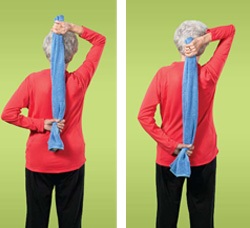
|
|
1. Stand with feet shoulder-width apart.
2. Hold one end of a towel in your right hand.
3. Raise and bend your right arm to drape the towel down your back. Keep your right
arm in this position and continue holding on to the towel.
4. Reach behind your lower back and grasp the towel with your left hand.
5. To stretch your right shoulder, pull the towel down with your left hand. Stop
when you feel a stretch or slight discomfort in your right shoulder.
6. Repeat at least 3-5 times.
7. Reverse positions, and repeat at least 3-5 times.
|
|
|
|
Upper Body
|
|
This exercise increases the flexibility of your arms, chest, and shoulders, and
will help you reach items on the upper shelves of your closet or kitchen cabinet.
|
|
|
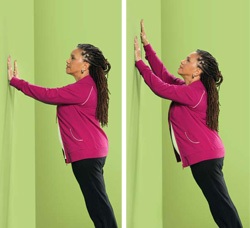
|
|
1. Stand facing a wall slightly farther than arm’s length from the wall, feet shoulder-width
apart.
2. Lean your body forward and put your palms flat against the wall at shoulder height
and shoulder-width apart.
3. Keeping your back straight, slowly walk your hands up the wall until your arms
are above your head.
4. Hold your arms overhead for about 10-30 seconds.
5. Slowly walk your hands back down.
6. Repeat at least 3-5 times.

As you progress, the goal is to reach higher.
|
|
|
|
Chest
|
|
This exercise, which stretches the chest muscles, is also good for your posture.
|
|
|
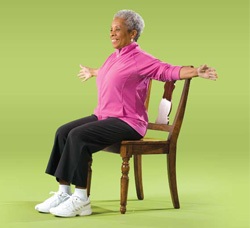
|
|
1. You can do this stretch while standing or sitting in a sturdy, armless chair.
2. Keep your feet flat on the floor, shoulder-width apart.
3. Hold arms to your sides at shoulder height, with palms facing forward.
4. Slowly move your arms back, while squeezing your shoulder blades together. Stop
when you feel a stretch or slight discomfort.
5. Hold the position for 10-30 seconds.
6. Repeat at least 3-5 times.
|
|
|
|
Back 1
|
|
This exercise is for your back muscles. If you’ve had hip or back surgery, talk with
your doctor before trying this stretch.
|
|
|
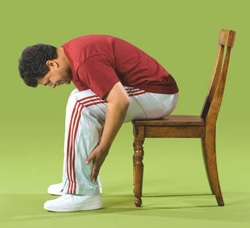
|
|
1. Sit securely toward the front of a sturdy, armless chair with your feet flat
on the floor, shoulder-width apart.
2. Slowly bend forward from your hips. Keep your back and neck straight.
3. Slightly relax your neck and lower your chin. Slowly bend farther forward and
slide your hands down your legs toward your shins. Stop when you feel a stretch
or slight discomfort.
4. Hold for 10-30 seconds.
5. Straighten up slowly all the way to the starting position.
6. Repeat at least 3-5 times.

As you progress, bend as far forward as you can and eventually touch your heels.
|
|
|
|
Back 2
|
|
This exercise will help you do activities that require you to twist or turn to look
behind you, such as backing out of a parking space or swinging a golf club.If you’ve
had hip or back surgery, talk with your doctor before trying this stretch.
|
|
|
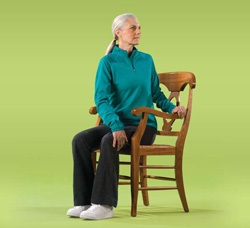
|
|
1. Sit up toward the front of a sturdy chair with armrests. Stay as straight as
possible. Keep your feet flat on the floor, shoulder-width apart.
2. Slowly twist to the left from your waist without moving your hips. Turn your
head to the left. Lift your left hand and hold on to the left arm of the chair.
Place your right hand on the outside of your left thigh. Twist farther, if possible.
3. Hold the position for 10-30 seconds.
4. Slowly return to face forward.
5. Repeat on the right side.
6. Repeat at least 3-5 more times.

As you progress, try lifting your left arm and resting it comfortably on the back
of the chair. Hold on to the left armrest with your right arm. Repeat on right side.
|
|
|
|
Upper Back
|
|
This exercise is good for your shoulders and upper-back muscles.
|
|
|

|
|
1. Sit in a sturdy, armless chair with your feet flat on the floor, shoulder-width
apart.
2. Hold arms in front of you at shoulder height with palms facing outward.
3. Relax your shoulders, keep your upper body still, and reach forward with your
hands. Stop when you feel a stretch or slight discomfort.
4. Hold position for 10-30 seconds.
5. Sit back up.
6. Repeat at least 3-5 times.

As you progress, cross your arms and interlace fingers.
|
|
|
|
Ankle
|
|
This exercise stretches your ankle muscles. You can stretch both ankles at once
or one at a time.
|
|
|

|
|
1. Sit securely toward the edge of a sturdy, armless chair.
2. Stretch your legs out in front of you.
3. With your heels on the floor, bend your ankles to point toes toward you.
4. Hold the position for 10-30 seconds.
5. Bend ankles to point toes away from you and hold for 10-30 seconds.
6. Repeat at least 3-5 times.
|
Source: nia.nih.gov
Flexibility Exercise Tips
- Do each stretching exercise 3 to 5 times at each session.
- Slowly stretch into the desired position, as far as possible without pain, and hold
the stretch for 10 to 30 seconds. Relax, breathe, then repeat, trying to stretch
farther.
For more tips on staying healthy, we invite you to visit our Healthy Living section.
|















